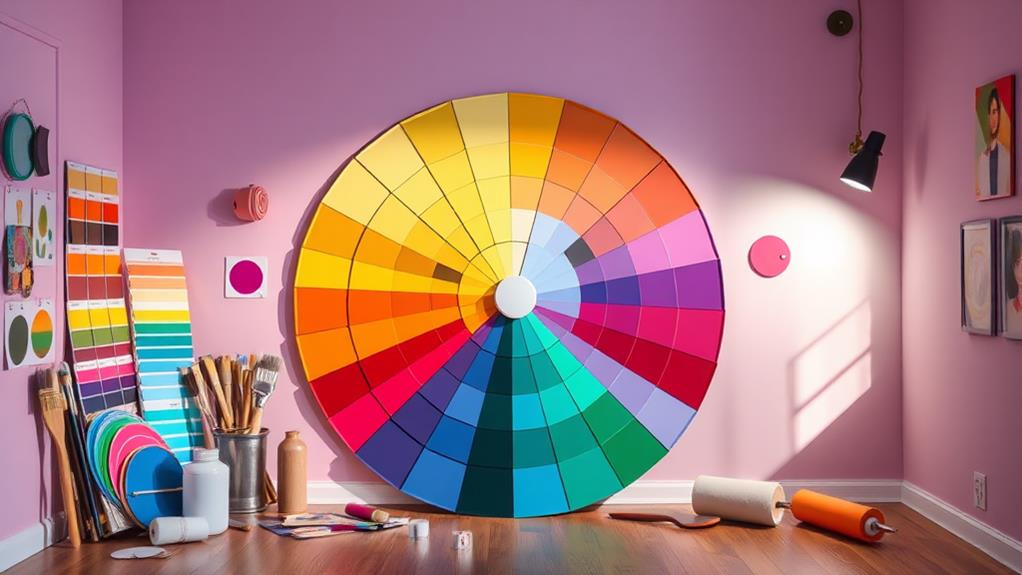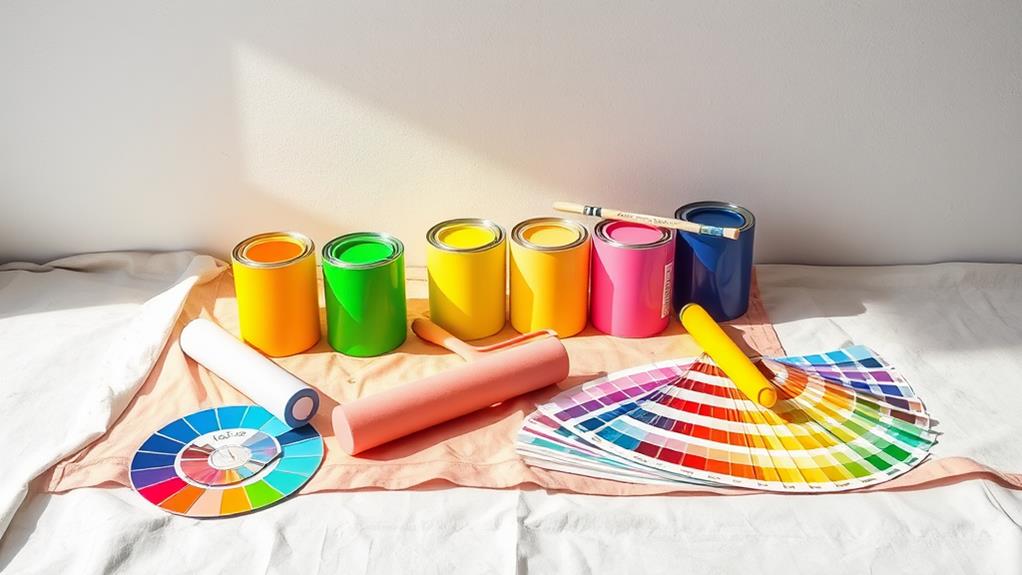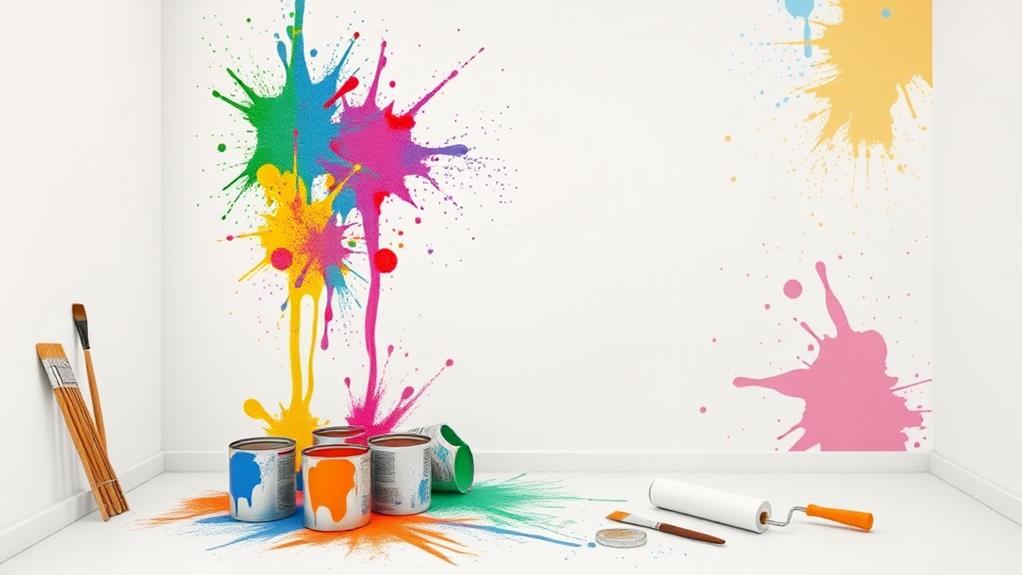Transforming rooms with color on a budget is an accessible and impactful way to revitalize your living space. By carefully selecting hues that complement your room's purpose and existing elements, you can create a dramatic change without overspending. Proper preparation, including cleaning and repairing surfaces, is crucial for a professional finish. Investing in quality tools and materials ensures better results and longevity. Mastering basic painting techniques, such as cutting in and even rolling, will elevate your DIY project. Incorporating budget-friendly design ideas like accent walls or upcycled furniture can further enhance the room's aesthetic. With the right approach, you'll unlock the power of paint to completely transform your space.
Choosing the Right Colors

When selecting colors for a room transformation, it's crucial to consider the space's purpose, size, and existing elements. Start by determining the mood you want to create—calming, energizing, or cozy. Cool colors like blues and greens tend to be soothing, while warm hues like reds and yellows can invigorate a space.
For smaller rooms, lighter shades can make the area feel more spacious, while darker tones can add depth to larger spaces. Consider the natural light in the room, as this can significantly affect how colors appear. Test paint samples on the walls and observe them at different times of day before making a final decision.
Take into account existing furniture, flooring, and fixtures when choosing your palette. Aim for a cohesive look by selecting colors that complement these elements. The 60-30-10 rule can be a helpful guide: use your dominant color for 60% of the room, a secondary color for 30%, and an accent color for the remaining 10%. This creates a balanced and visually appealing space without overwhelming the senses or budget.
Preparing Your Space
Preparation is key to achieving a successful and cost-effective room transformation. Before applying paint, thoroughly clean all surfaces to remove dirt, dust, and grease. Repair any cracks, holes, or imperfections in the walls using spackling compound or joint compound. Sand these areas smooth once dry to ensure a seamless finish.
Remove or cover all furniture, fixtures, and flooring to protect them from paint splatters. Use drop cloths, plastic sheeting, or old bedsheets for this purpose. Remove switch plates, outlet covers, and any other hardware from the walls. Apply painter's tape to trim, windows, and doors to create clean, sharp lines.
Prime the walls if necessary, especially when covering dark colors or working with porous surfaces. This step ensures better paint adhesion and more accurate color representation. Choose the appropriate primer based on your surface type and desired finish.
Gather all necessary tools and materials before starting, including paint rollers, brushes, trays, and a ladder or stepstool for reaching high areas. Properly ventilate the room by opening windows and using fans to circulate air, promoting faster drying and reducing paint fumes.
Essential Tools and Materials

Equipping yourself with the right tools and materials is crucial for a successful and budget-friendly room transformation. Start with quality paint brushes and rollers appropriate for your surface type. Invest in a sturdy ladder or step stool for reaching high areas safely. Painter's tape is essential for clean lines and protecting surfaces you don't want painted.
For wall preparation, gather sandpaper, spackle, and a putty knife to smooth imperfections. A drop cloth will protect your floors and furniture from paint splatters. Don't forget cleaning supplies like all-purpose cleaner and rags for wiping down surfaces before painting.
When selecting paint, choose a high-quality brand that offers good coverage to minimize the number of coats needed. Consider purchasing a paint and primer combination to save time and money. For most rooms, you'll need 1-2 gallons of paint per 400 square feet of wall space.
Additional helpful items include a paint tray, stirring sticks, and a can opener for paint cans. If you're tackling a large project, a paint sprayer can speed up the process and provide even coverage on textured surfaces.
Painting Techniques for Beginners
For beginners embarking on their first painting project, mastering a few basic techniques can make a significant difference in the final result. Start by cutting in, which involves using a brush to paint a clean line where the wall meets the ceiling, baseboards, or adjacent walls. This technique requires a steady hand and patience but ensures crisp edges.
Next, learn the "W" technique for rolling paint onto walls. Load the roller with paint and apply it in a large "W" shape, then fill in the gaps without lifting the roller. This method helps distribute paint evenly and avoid streaks. When painting large areas, work in sections and maintain a wet edge to prevent visible seams.
For textured walls, use a thicker nap roller to ensure paint reaches all crevices. On smooth surfaces, a shorter nap roller will suffice. Always paint from top to bottom to catch any drips. Between coats, wrap rollers and brushes in plastic wrap to keep them moist, saving time and materials. Finally, remove painter's tape while the paint is still slightly wet for cleaner lines.
Budget-Friendly Design Ideas

Transforming a room's appearance doesn't always require a hefty investment. With strategic use of color and creativity, you can achieve stunning results on a budget. Consider accent walls to create visual interest without painting an entire room. Choose a bold, contrasting color for one wall to serve as a focal point and add depth to the space.
Upcycling existing furniture with a fresh coat of paint can breathe new life into old pieces. Experiment with chalk paint for a vintage look or high-gloss finishes for a modern touch. Incorporate colorful accessories like throw pillows, curtains, or area rugs to introduce pops of color without committing to permanent changes.
DIY artwork can add personality and color to your walls affordably. Create abstract pieces using leftover paint or frame colorful fabric swatches for instant wall decor. Use removable wallpaper or decals to add patterns and colors without the commitment or cost of traditional wallpaper.
Lastly, don't underestimate the power of lighting. Colorful lampshades or painted light fixtures can dramatically alter a room's ambiance and inject vibrant hues into your space without breaking the bank.
Frequently Asked Questions
How Long Does Paint Typically Take to Fully Cure?
Paint typically takes 24 to 48 hours to dry to the touch, but full curing can take up to 30 days. Factors like humidity, temperature, and paint type can affect this timeframe. Always consult the manufacturer's recommendations for specific guidance.
Can I Use Interior Paint for Outdoor Projects?
Like a fish out of water, interior paint isn't designed for outdoor use. While tempting, it lacks the durability and weather resistance needed for exterior projects. Opt for specially formulated exterior paints to ensure longevity and protection against the elements.
What's the Best Way to Dispose of Leftover Paint?
To dispose of leftover paint responsibly, allow it to dry completely or mix with cat litter. Check local regulations for proper disposal methods. Many communities offer paint recycling programs or hazardous waste collection events for safe disposal.
How Do I Remove Paint Stains From Clothing or Carpet?
Time is of the essence when tackling paint stains. For clothing, blot with a solvent-based cleaner before laundering. On carpets, use a mixture of dish soap and warm water, gently blotting from the outside inward. Always test inconspicuous areas first.
Are There Any Health Risks Associated With Paint Fumes During Pregnancy?
Paint fumes during pregnancy can pose potential health risks. Exposure to volatile organic compounds (VOCs) may affect fetal development. Pregnant women should avoid freshly painted areas, ensure proper ventilation, and use low-VOC or zero-VOC paints when necessary.
Conclusion
Color wields the power to metamorphose spaces from drab to dazzling, breathing new life into every corner. With careful planning, preparation, and technique, even novice painters can achieve professional-looking results. By selecting the right hues, gathering essential tools, and employing basic painting methods, budget-conscious homeowners can create stunning transformations. The possibilities are endless, from accent walls that pop like fireworks to subtle color schemes that soothe the soul. Embracing the art of paint can revolutionize living spaces without breaking the bank.

